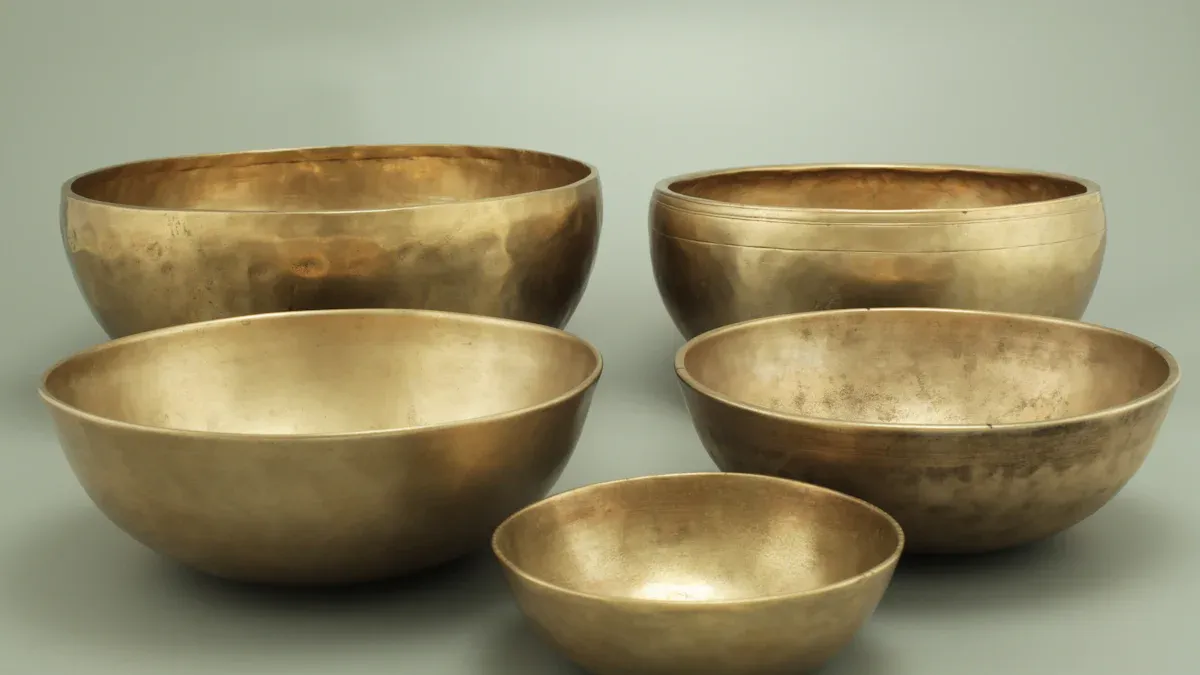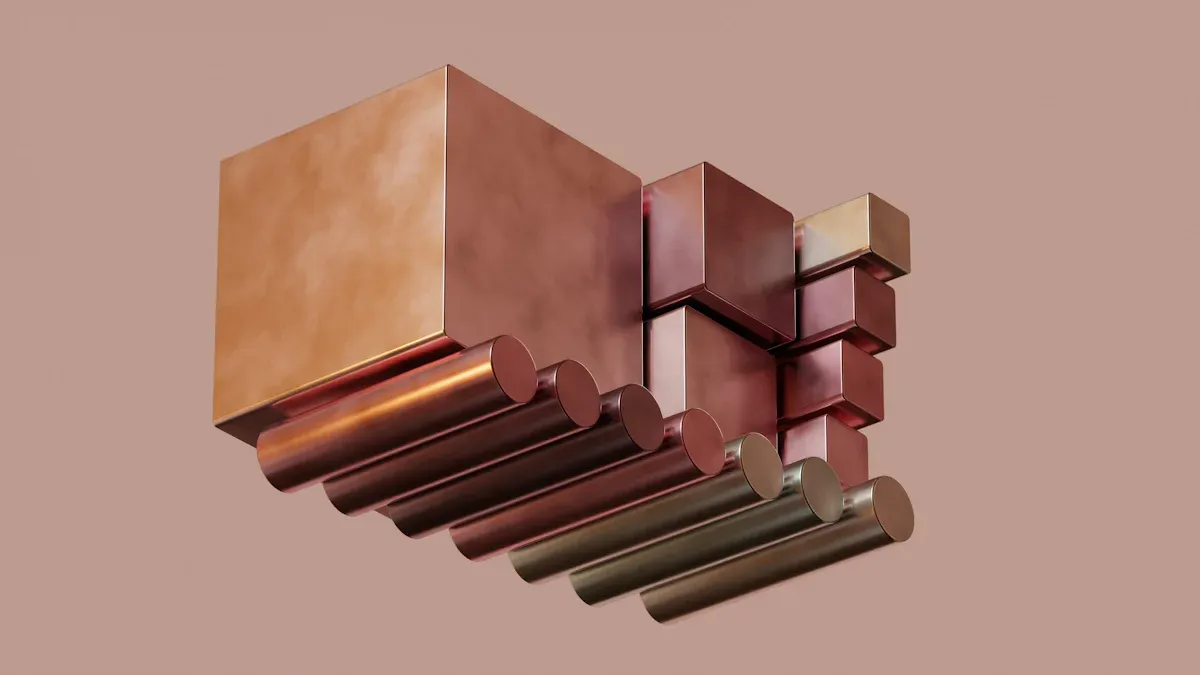
Tin bronze plays a vital role in industries like automotive, marine, and aerospace, which fields prefer to use Tin bronze due to its exceptional properties. The Tin bronze feature of wear resistance and its advantage of corrosion protection make it indispensable across these sectors. The global market, valued at $1.64 billion in 2023, is projected to grow steadily, driven by innovations and sustainable practices. Companies like Pingheng Machinery feature products that cater to diverse industrial needs with precision and quality.
Key Takeaways
- Tin bronze is important for cars, ships, and planes. It resists wear and prevents rust.
- Using lead-free tin bronze helps the environment and follows rules for cleaner production.
- New alloy ideas improve tin bronze, so it works better under heavy use.
What is Tin Bronze?
Composition and Properties
Tin bronze is a copper-based alloy that combines copper with tin and other elements to create a material with exceptional properties. Its composition typically includes 81–85% copper, 6.3–7.5% tin, and small amounts of lead, zinc, and other elements. These elements enhance its strength, corrosion resistance, and machinability. The table below highlights the chemical composition of tin bronze:
| Element | Percentage (%) |
|---|---|
| Copper (Cu) | 81.0 – 85.0 |
| Tin (Sn) | 6.3 – 7.5 |
| Lead (Pb) | 6.0 – 8.0 |
| Zinc (Zn) | 2.0 – 4.0 |
| Iron (Fe) | 0.20 max |
| Nickel (Ni) | 1.00 max |
This alloy also boasts impressive physical properties, such as a density of 0.322 lb/in³ and excellent thermal conductivity. These attributes make it a preferred choice for applications requiring durability and efficiency.

Historical and Modern Significance
Tin bronze has a rich history dating back thousands of years. Ancient civilizations used it for tools, weapons, and art due to its malleability and strength. Over time, its applications expanded into architectural ornamentation and coinage, showcasing its versatility.
In modern industries, tin bronze continues to shine. It plays a crucial role in marine components, bearings, and bushings, thanks to its wear resistance and corrosion protection. Its acoustic properties make it ideal for musical instruments like cymbals and bells. Additionally, advancements in alloy technology have enhanced its machinability and performance under high-stress conditions, ensuring its relevance in aerospace, automotive, and precision casting applications.
Tin bronze’s evolution from ancient artifacts to cutting-edge industrial components highlights its enduring value and adaptability.
Which Fields Prefer to Use Tin Bronze?

Bearings and Bushings
Tin bronze is a go-to material for bearings and bushings due to its exceptional mechanical properties. It offers high strength, hardness, and ductility, making it ideal for components that endure heavy loads and constant motion. Its wear resistance ensures durability, while its corrosion resistance makes it suitable for challenging environments like seawater or brines. For example, the C93200 alloy stands out for its self-lubricating properties, reducing friction and wear in medium-load, medium-speed applications. These qualities make tin bronze indispensable in industries like automotive and industrial machinery.
Marine Components
Marine environments demand materials that can withstand harsh conditions, and tin bronze excels in this role. Its excellent corrosion resistance, especially in saltwater, ensures long-lasting performance. The alloy’s tensile strength ranges from 240 to 900 MPa, while its fatigue strength reaches approximately 16 ksi at 100 million cycles. These metrics highlight its ability to endure the stresses of marine applications. From propellers to pump components, tin bronze remains a trusted choice for shipbuilding and offshore equipment.
Electrical and Electronic Products
Tin bronze plays a vital role in electrical and electronic products. Its good electrical conductivity and mechanical strength make it perfect for switches, connectors, and terminals. The alloy’s corrosion resistance ensures reliable performance in various environments, including those with high humidity or exposure to chemicals. These properties make tin bronze a preferred material for manufacturers aiming to produce durable and efficient electrical components.
Automotive and Engineering Machinery Applications
The automotive and engineering sectors rely heavily on tin bronze for components like bearings, bushings, and gears. Its high mechanical strength and excellent wear resistance ensure these parts can handle significant loads and repeated stress. For instance, the tensile strength of C93200 alloy varies by casting method, with continuous castings achieving a minimum of 35 ksi. This strength, combined with its anti-friction qualities and durability, makes tin bronze a dependable choice for dynamic applications in heavy machinery and vehicles.
Tin bronze’s versatility across these fields highlights its importance in modern manufacturing. Whether in marine, automotive, or electrical applications, it continues to deliver unmatched performance and reliability.
Advantages of Tin Bronze
Wear Resistance and Durability
Tin bronze stands out for its exceptional wear resistance and durability, making it a top choice for industries requiring long-lasting components. Its tensile strength ranges from 30-35 ksi, while its Brinell hardness measures between 65-70. These properties ensure that tin bronze can handle heavy loads and constant motion without significant wear. Additionally, its compressive strength of approximately 46 ksi and fatigue strength of ~16 ksi at 100 million cycles highlight its ability to endure repeated stress over time.
Industries like automotive and aerospace rely on tin bronze for bearings and bushings due to its anti-friction qualities. The high lead content in certain alloys reduces wear, resulting in components that last longer and require minimal maintenance. This durability makes tin bronze a reliable material for demanding applications.
Corrosion Resistance in Harsh Environments
Tin bronze excels in environments where corrosion resistance is critical. Marine applications, such as ship propellers and rudders, benefit from its ability to resist seawater corrosion. This property reduces maintenance needs and ensures long-term reliability. Similarly, fittings in saline environments showcase tin bronze’s durability under harsh conditions.
Its resistance to corrosion extends beyond marine uses. Tin bronze performs well in mildly corrosive environments, making it suitable for a variety of industrial applications. This versatility ensures that industries can depend on tin bronze for components exposed to challenging conditions.
Machinability and Versatility
The machinability of tin bronze enhances its appeal across industries. Variations in its chemistry, such as the addition of lead, improve machinability and pressure tightness. For example, MTEK 65 / C90700, with 89% copper and 11% tin, is widely used for gears, bearings, and bushings due to its strong mechanical properties.
Tin bronze’s versatility extends to heavy load applications, marine components, and steam fittings. Alloys like MTEK Navy G 1% Lead / C92300 and MTEK Leaded Tin Bronze / C92700 demonstrate its adaptability for specific uses. This flexibility ensures that industries can tailor tin bronze to meet their unique requirements.
Tin bronze’s combination of wear resistance, corrosion protection, and machinability makes it indispensable in modern manufacturing. It continues to deliver unmatched performance across various fields, including those which fields prefer to use Tin bronze ? like automotive and marine industries.
Innovations and Future Trends

Development of Lead-Free Tin Bronze Alloys
The shift toward lead-free tin bronze alloys is transforming industries. These alloys offer a safer, eco-friendly alternative to traditional materials, meeting the growing demand for sustainable solutions. Industries like automotive, aerospace, and marine are leading this change, with a projected growth rate of 4.2% from 2024 to 2030. This trend reflects the increasing preference for non-toxic materials that align with environmental regulations.
Manufacturers are also embracing recycled copper and tin in their production processes. This approach reduces the need for mining, lowers energy consumption, and minimizes greenhouse gas emissions. The Lead-Free Tin Bronze Rod market, valued at $1.02 billion in 2022, is expected to reach $1.44 billion by 2030. This growth highlights the rising demand for environmentally sustainable materials across various sectors.
Enhanced Alloy Performance for High-Stress Applications
Tin bronze alloys are evolving to meet the demands of high-stress applications. Recent studies reveal that adding tin to Nickel Aluminum Bronze (NAB) alloys can significantly enhance their mechanical properties. For instance, a 2023 study showed that a 1.0 wt% tin addition improved hardness by 69% and tensile strength by 28.4%.
Another study in 2024 explored medium-entropy bronze alloys with varying tin content. It found that alloys with over 5 wt% tin delivered optimal performance, including improved wear resistance and mechanical strength. These advancements make tin bronze a reliable choice for industries requiring durable materials, such as aerospace and heavy machinery.
Sustainability and Recycling in Tin Bronze Production
Sustainability is becoming a cornerstone of tin bronze production. Foundries have long practiced recycling by remelting old metals, which minimizes waste while maintaining quality. Reusing scrap materials not only saves costs but also reduces environmental impact.
Energy-efficient technologies are also gaining traction, helping manufacturers lower energy consumption and operational costs. These practices enhance market competitiveness by meeting consumer and regulatory demands for sustainable products. The table below summarizes key sustainability practices in tin bronze production:
| Evidence Type | Description |
|---|---|
| Recycling Practices | Foundries have a long history of remelting old metals, which minimizes waste and maintains quality. |
| Waste Reduction | Reusing scrap materials helps save costs and reduces environmental impact. |
| Energy Efficiency | Adoption of energy-efficient technologies lowers energy consumption and operational costs. |
| Market Competitiveness | Sustainable practices enhance competitiveness while meeting consumer and regulatory demands. |
These innovations ensure that tin bronze remains a vital material for industries prioritizing sustainability and efficiency.
Tin bronze continues to shine as a cornerstone material across industries. Its wear resistance, corrosion protection, and machinability make it indispensable for automotive, marine, and engineering applications.
- Industries benefit from its versatility and reliability.
- Innovations like 3D printing enable intricate designs, boosting efficiency.
- Automation and AI enhance precision in production processes.
In 2025, companies like Ningbo Pingheng Machinery Co., Ltd. are driving advancements in alloy technology. Tin bronze remains vital for sustainable and innovative industrial solutions.
FAQ
What makes tin bronze a preferred material for industrial applications?
Tin bronze offers excellent wear resistance, corrosion protection, and machinability. Companies like Ningbo Pingheng Machinery Co., Ltd. provide high-quality tin bronze components for diverse industries.
Can tin bronze be recycled?
Yes! Tin bronze is highly recyclable. Foundries, including Ningbo Pingheng Machinery Co., Ltd., often remelt scrap materials to create sustainable and efficient industrial solutions.
How does Ningbo Pingheng Machinery Co., Ltd. contribute to tin bronze innovation?
The company uses precision casting techniques to produce tin bronze components for automotive, marine, and engineering sectors. Their expertise ensures reliable and durable solutions for modern industries.
